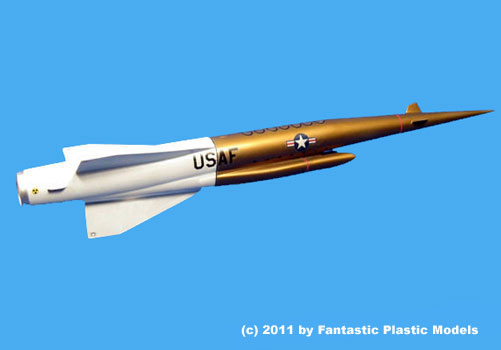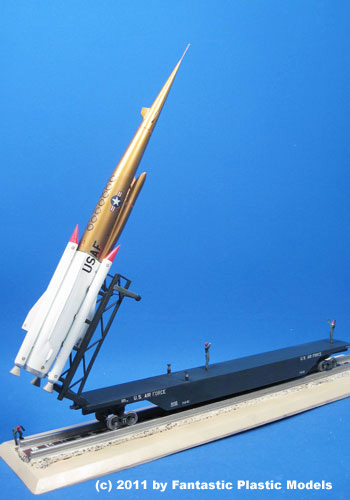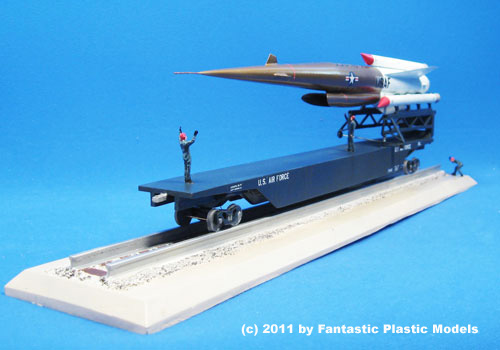Plugging away on details now.
From Fantastic Plastic, the 1/72 Pluto/SLAM model I mastered a while back:



It is available HERE.
NOTE: The kit has been retired.
http://fantastic-plastic.com/ProjectPlutoCatalogPage.htm
And to help with the detailing, don’t forget to pick up your Project Pluto CAD drawings, available to download for $3.
———–
———–
————-
And For Grud’s sake, if you are going to build a Pluto model, you have to download a copy of Aerospace Projects Review issue V2N1 with the ginormous Pluto article…

Available to download for a miniscule $8.00!
————
A blog reader came through on the BluRay screenshots from “2001,” and they proved to be a lot better than my own DVD screenshots. Not terribly surprising, of course. They revealed a lot of details that were previously just small blurs. That’s good… lets me be accurate. That’s also bad… it shows me that the Station had a *lot* of little detail bits.
Here is a render of part of the model showing the current state of things. The greeblies on the spokes are completely different, and the spokes now feature additional cables running along the surface. The inner surface of the rim now features a good chunk of the detailing it needs… the broader strokes are in place, but a boatload of greeblies are needed. Windows are now punched into the rim surface… these windows are accurately placed.
My hope here is to end up with a Space Station V model that anybody would look at and say “yup.” The beauty of CAD is that after all the work is done, when the kit master parts are printed and cleaned up, the molds are made and the kit in production, I could theoretically always print out a bigger version. I’ve seen a number of people online making large-scale Space Station V models, either for themselves or intended as kits… around 30 inches diameter seems to be the general consensus. Not sure where I’d put a model that big, and I *know* I couldn’t afford to print one off that big… but it’s nice to know that it’s always a possibility.
A few photos of a McDonnell-Douglas display model of a DC-10 modified to launch a pair of MX (or MX-like) ICBMs. The missiles are held in pneumatic tubes, with a high pressure gas system near the nose of each missile; clearly, the missiles would not be simply slid out the back, but rather *shot* out the back with some authority. While the photos do not show the underside of the aft fuselage, clearly there has been some major modification to the design there. Less obvious is a change to the outer moldline of the upper fuselage… “bumps” are added to provide sufficient clearance for the angled missile tubes.
Here are the first in-progress shots of the SSV CAD model being built with Rhino 3D. Most of the structure is worked out, but there’s a lot of surface detail to be fleshed out (is there *anybody* with the ability to take screenshots from the “2001” BluRay???). The model is being built for accuracy first, then some of it will be backed off a bit for the actual 3D printing process.. Some of the important details, especially those along the cables suspended alongside the spokes (the stuff in green), would be probably impossible to print, mold and cast reliably at small size, so some adjustments may be required.
This (68 megabyte ZIP folder of jpg images) package contains diagrams to be used in the construction of accurate display models of the B-47. Includes:
1) Boeing drawing 23-2305, “Boeing B-47E Model Drawings 1/100 Scale,” 9000X5432 pixels, dated 1956
2) Boeing drawing 14-5068, “Boeing XB-47 Stratojet Model Drawing,” 13408X8412 pixels, dated 1947
Also included are halfsize and quartersize version for easier viewing and printing.
Air Drawing 57 can be downloaded for $$4.50.
————
————
My next model project for Fantastic Plastic has been confirmed: Space Station V from “2001: A Space Odyssey.” This will be mastered as a CAD model and printed out. The current plan is to include parts for both a *complete* SSV (all resin) and as the *incomplete* SSV as seen in “2001” (with photoetch parts).
Also to be included: Orion III spaceplane. There will, in fact, be *two* Orion III’s, and for a good reason: scale. Since there are no “canon” diagrams of the SSV laying out exactly how big it is, people speculate and make measurements off of screen captures. The closest there is to an “official” diameter was 1000 feet, based on some thing written by tech advisor Fred Ordway. But while the model may have been built to represent that diameter, the story goes that Kubrick thought the station looked too small compared to the Orion III, so he arbitrarily “scaled it up” optically to twice the diameter… 2000 feet. So what the FP kit will do is have two Orion IIIs, one twice the size of the other. The scale of the kit will then be up to the model builder. Current plan is to produce the model at about 8.57″ diameter… meaning either 1/1400 or 1/2800 scale, depending on which Orion III you choose.
Note: the scales listed on the Fantastic Plastic website are a little different from here. At this stage it’s no matter… it’s being built in the computer and can be adjusted with ease. The specifics will be determined a little later.
So.
Does anyone have a BluRay of “2001” and the ability to make full-rez screencaptures? If so, there are some shots that I would really appreciate.
Might be of interest to some of y’all… NASA has a page with a number of 3D CAD models. Stuff like Shuttle, Saturn V, Skylab, etc.
A recent project for a client: replicating a display model stand. The stand to be replicated was for a vintage Lockheed aircraft display model that did not have the original stand. A vintage Lockheed stand was produced to be copied. The stand was composed of a turned walnut base and a specially bent aluminum rod. The walnut based was outsourced to a local woodshop; the aluminum rod was fabricated in-house. This involved turning the exposed end of the rod, bending the rod around a special form and machining flats into the end of the rod to be inserted into the base. Once it was shaped and checked, it was potted in with epoxy, and the underside “fuzzed” in a manner similar to the original. Two bases were fabricated simultaneously to assure that a backup was on-hand in case anything unfortunate occurred. As it turns out, both turned out just fine, so I have a spare Lockheed display stand (used for aircraft such as the F-104 Starfighter, among others). If you are interested in it, contact me.
Photos below show the original Lockheed stand and the two replicas (with blue tape on the aluminum support rods).
A recent project: restoring the decals and finish on a vintage X-24A display model. The paint was to be left as-is; existing cracks and blemishes in the surface were not to be repaired. The goal was to make a display model that retained the appearance of being vintage… just not quite so beat up.
“Before” photos:
Since the paint was to be left alone, the decals could not be sanded or scraped off. Instead, they were removed chemically (primarily: dihydrogen monoxide). In the process of doing so, the overcoat was found to be soluble. Photo below shows the model halfway through the process, with the port side of the craft cleaned of the decals and overcoat, leaving decals and overcoat on the starboard side. The underlying silver paint was found to be substantially brighter with the overcoat off. Presumably the overcoat had fogged over the years due to oxidation and/or UV.
Decals are not available off-the-shelf for this display model, so detailed photos and measurements were made. JBOT Decals was contracted to produce a new set of replacement decals.
Some of the overcoat stubbornly clung to the model. The main patches were on the underside, indicating UV damage as the likeliest of cuplrits for both the oxidation and “loosening” of the stuff. As a result, it was necessary to touch up small portions of the surface; an extensive selection of “silver” paint was procured and one found that matched the existing silver. The patches that needed touchup – and only those patches – were painted and blended in. The end result is invisible. The pitot tube was a red-painted steel rod that had rusted; it was carefully cleaned and repainted.
A thin glosscoat was applied and then the decals; a satin clearcoat was then applied over the decals, finishing the process. The end result is a model with virtually invisible repairs to the decals; with the exception of the pre-existing surface imperfections, it looks right-out-of-the-box.
This model was restored for collector and aviation photography Chad Slattery, owner/proprietor of Chad Slattery Photography. Mr. Slattery kindly provided this testimonial:
Scott’s engineering background, combined with his meticulous craftsmanship and deep knowledge of aviation history, make him the go-to resource for restoring (or re-creating) desktop models. He sends photos to help explain procedures, makes regular progress reports, and is careful to only do what is requested. I cannot recommend him highly enough.
If you have a vintage display model in need or repair – or if you want to commission an entirely new one, just let me know.

















